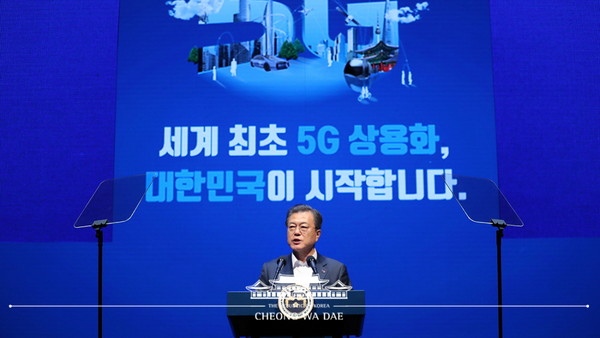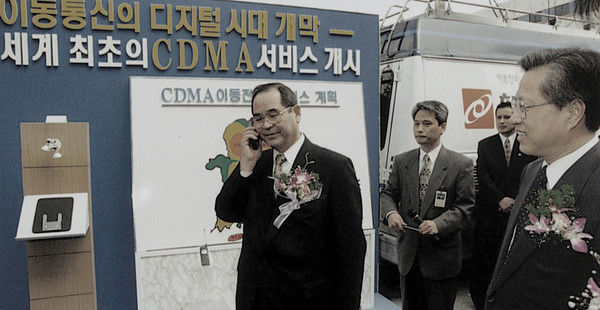By Jenny Lee WIRED Korea
When it comes to internet speed and service, no country on this planet beats South Korea. It also stands out as the most heavily connected country in the world, with at least 95 percent of its population using the lightning-fast internet on a wide range of digital devices.
Home to a number of the world’s leading tech companies like Samsung, LG, SK and KT, Korea has ranked first in the Information and Communication Technology (ICT) Development Index for multiple years and still reigns supreme on the Bloomberg Index of “Most Innovative Economies.”
Clearly, Korea has set itself as a global ICT leader. But how did it get there?
While there were a few factors that have helped technology grow by leaps and bounds in the country which once was a heap of rubble after the 1950-53 Korean War, one was particularly helpful: government intervention and investment.
The Korean government’s active role in ICT is no better encapsulated by the image of President Moon Jae-in exuding confidence when he was announcing the rollout of the world’s first 5G commercial service last April. But its history goes back years and years – to the late 1980s and early 1990s, when the government was just beginning to invest aggressively in telecommunications research and development to secure core, indigenous technologies.

Cho Shin, a professor at Yonsei University’s Graduate School of Information, explained that during the period, it launched a bold initiative to develop a digital cellular system with the goals of providing better services and bolstering the domestic mobile telecommunication industry. The Electronics and Telecommunications Research Institute (ETRI), the then research arm of the Ministry of Information and Communications, was in charge of the job.
“With several digital cellular technologies competing for marketplace dominance at the time, the big question for ETRI was which one of them it would invest in and roll out as a national standard across Korea,” Cho said.
The options included Time Division Multiple Access (TDMA) and its variant, known as Global System for Mobile Communication (GSM), the two most widely-used wireless technologies that are capable of supporting a wide range of services and applications.
But in 1989, the institute made a strategic decision to rather adopt and commercialize the Code Division Multiple Access (CDMA) cellular system pioneered by a then small venture firm in the United States, Qualcomm.
“Although it was not field-proven and therefore risky, CDMA was deemed technologically more advanced than its rivals,” Cho said. “For example, their capacity for communication was greater.”
ETRI with Qualcomm formed a consortium with Korean manufacturing companies including Samsung and LG as well as mobile carriers, to which they assigned different tasks such as designing and building CDMA networks, systems and devices and testing, evaluating and rolling out mobile services.

In 1996, SK Telecom launched Korea’s first commercial CDMA digital cellular service, with four others following suit one after another.
“The successful CDMA commercialization became the bedrock of modern communications infrastructure,” Cho said. “It also paved the way for companies to grow in large scales.”
From the analog 1G networks of the 1980s through the digital 2G, 3G and 4G LTE systems, the growth in speed and capacity has allowed new technologies to transform Korea and the entire world to be smarter and better. And ETRI has for sure played an important role.
In this 5G era, however, ETRI and more broadly the government are taking a back seat to the network operators in development and commercialization, despite their outward appearance of active involvement. Experts say they are assisting private manufacturing sectors at best, creating an atmosphere that would facilitate their quick deployment of 5G.
“Gone are the days when ETRI was superior to private sectors, which had lacked financial power and technical skills to develop ICT technologies independently,” said Lee Seong-Yeob, a professor at the Graduate School of Management of Technology at Korea University. “But things are different now.”
“While technology development capabilities of private manufacturers and telecommunications companies have increased significantly, those of ETRI have weakened due to the relocation of ETRI professionals to the private sector during the 2008 financial crisis and when the Ministry of Information and Communication was dissolved that same year.”
When asked of its place in Korea’s 5G network infrastructure, ETRI was well aware of its weakening role.
“It is true that major companies in mobile communications including Samsung, LG, Qualcomm, Ericsson and Nokia are leading the way in LTE or 5G technologies,” said Ko Young-jo, director of the 6G wireless technology research section at ETRI. “The numbers (of engineers) alone are so large that they can't be compared to that of this relatively small research lab.”
“But even though we don't play a big technical role anymore, we contribute to the standardization process.”
Nevertheless, the presence of the government-funded research institute is still vital. A slight repositioning is all that is needed, experts say.
“The role of government-funded research institutes such as ETRI should be taking the lead in mid- and long-term research projects that are necessary for the nation's future but difficult for businesses and universities to undertake,” Lee said.
These projects may involve quantum computing and artificial intelligence, Cho said.


 뉴스레터 신청
뉴스레터 신청